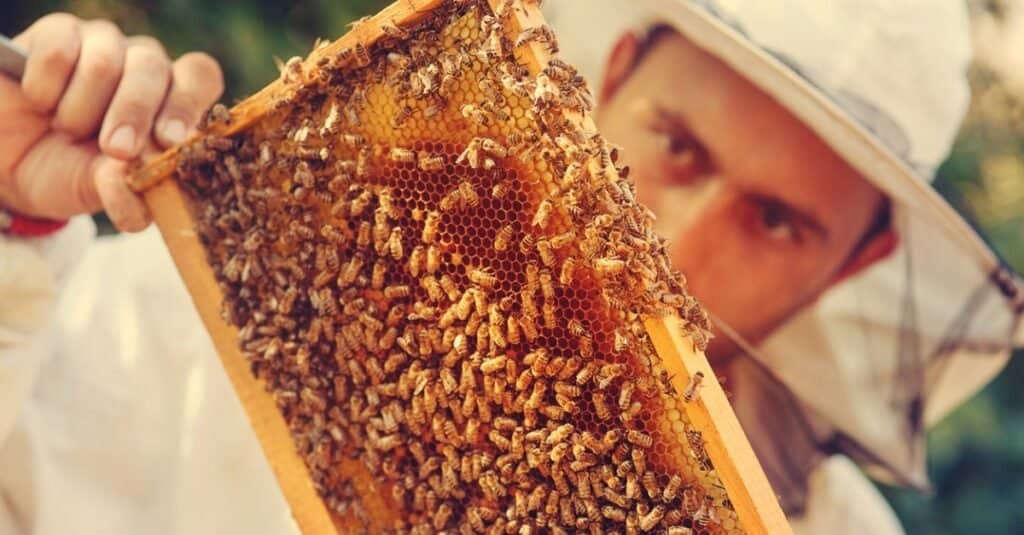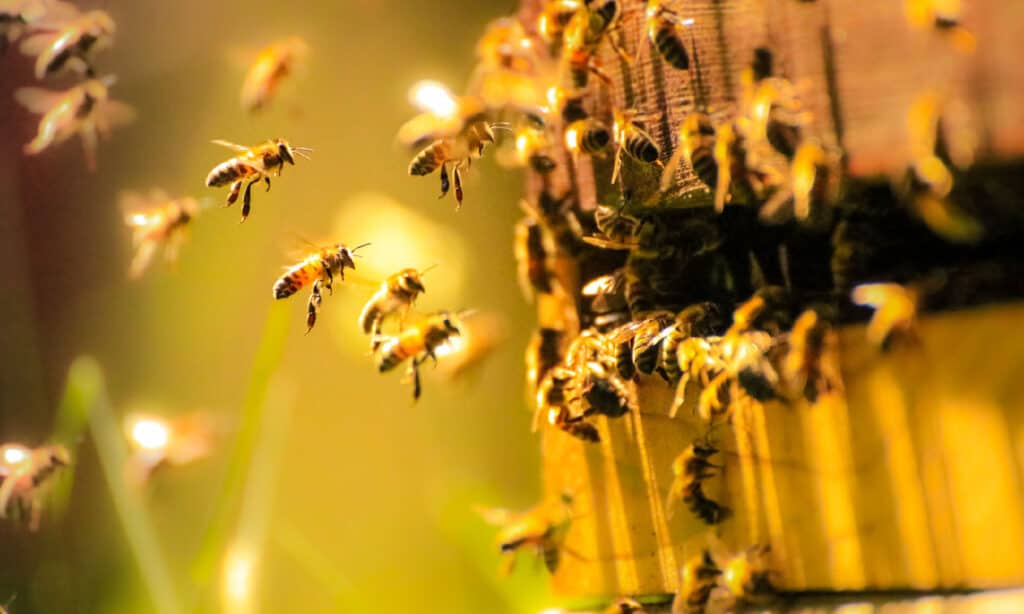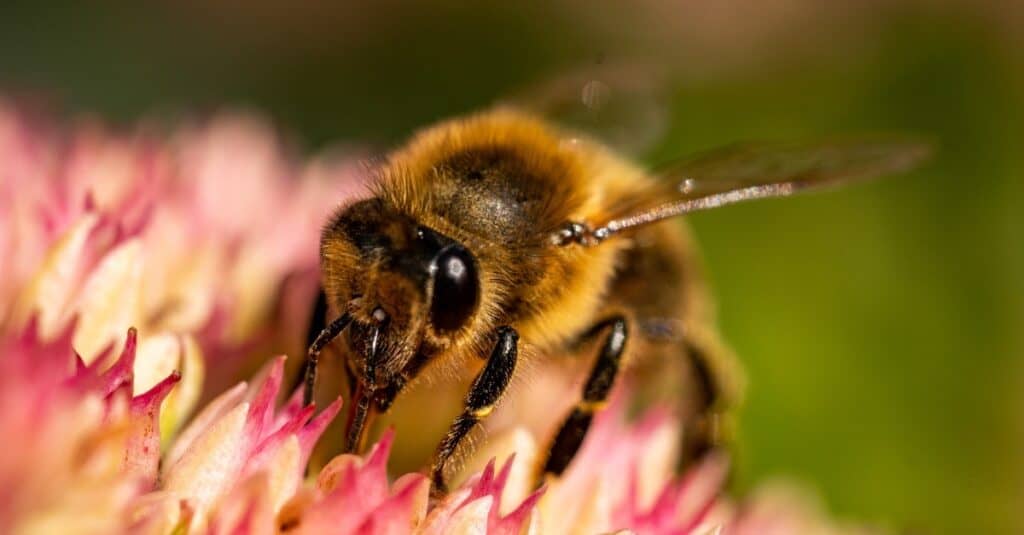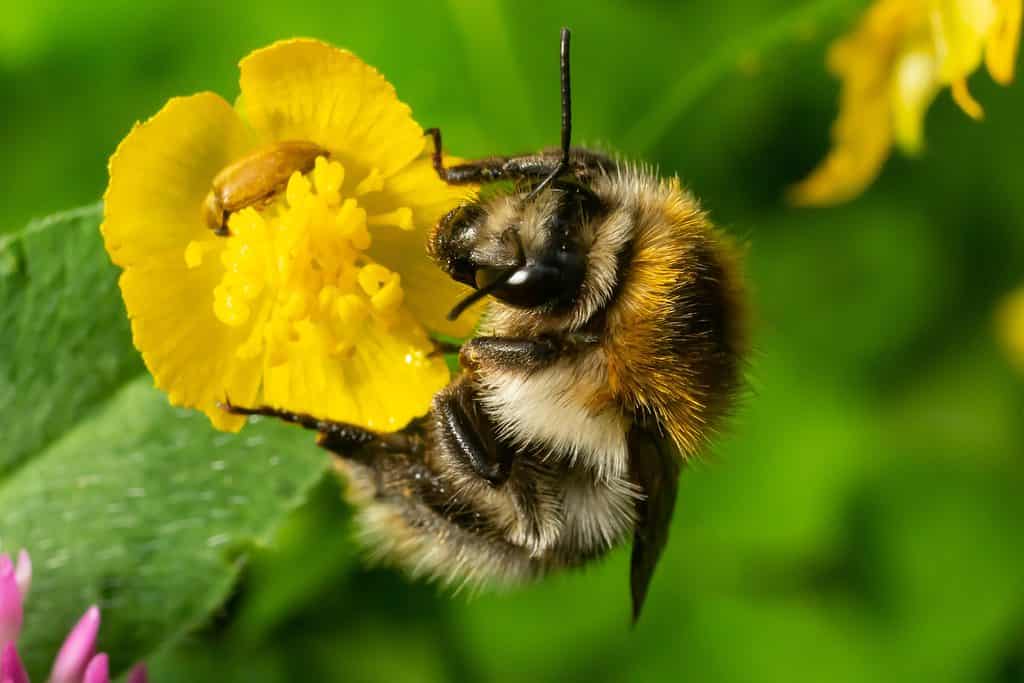The sudden sound of buzzing by your ear in the spring or summer may send you running and ducking awkwardly or slapping wildly at your own head. The worst is when this happens mid-conversation. Or you might be one of those cool, calm, and collected folks who doesn’t even bat an eye around bees. Wherever you stand between these two extremes, you know honey bees are a part of life when the weather is warm. But do you know when they come out near you? Let’s find out!
Are Honey Bees Native to the United States?
Honey bees, scientific name Apis mellifera, are not native to the United States. They were imported from Europe in the early 1600s to produce both sugar and wax. Eventually, beekeepers started selecting their honey bees based on preferred temperaments and productivity to eventually harvest their honey and have them pollinate crops. They also considered their physical features and their ability to resist disease to ensure health and longevity. Essentially, in the United States, honey bees are domesticated.

Essentially, in the United States, honey bees are domesticated.
©iStock.com/djiledesign
How Do Honey Bees Build Their Hives?
When wild, honey bees build their hives in rocky places where there are crevices they can take advantage of. They may also gravitate toward a hollow tree that offers cover. Domesticated honey bees construct their hives in wooden boxes that can be stacked on top of one another. Whether in the wild or domesticated, they each chew wax to soften it before moving forward with bonding it, creating the little compartments, or cells, inside of the honeycomb. The honeycomb serves as the place to store both their protein and carbohydrate sources (pollen and honey).
Honey Bees’ Spring and Summer Activity
Before understanding the honey bees’ activity, it’s important to understand what a honey bee colony is comprised of. There is typically a single queen bee that has a sole purpose — to lay eggs. Colonies vary in size but at any given time, there could be up to 60,000 worker bees, which are sexually immature females. Sometimes, there may be a couple of hundred drones (if the season and colony population permit). As the young bees emerge, they are reared within the hive and eventually take over the older adult bees.
Spring
In the earlier part of spring, there is an abundance of pollen and nectar that promote brood rearing. The honey bees get busy gathering water to keep temperatures regulated. They soften and liquefy honey to ensure brood food is properly prepared. During this time, drones are not present. If they are, their numbers are scant. In late spring, the honey bee population multiplies, and young bees become a more sizable part of the colony. During this time, there are more field workers busy collecting nectar and pollen.
Summer
As longer days approach and temperatures increase, the colony continues growing, and drones get made. This is around the time when you might spot an overcrowded hive. Like a bar that spills its patrons out onto the sidewalk in huddled groups, you can typically spot several clusters just outside the hive entrance when there’s too much activity inside. When it’s crowded, the queen bee is busy laying drone eggs to prepare for what comes next: swarming.
Swarming happens when the colony splits to prepare a new home for the new virgin queen bee. Once they’ve secured a new location, they’re quick to set up new honeycombs. They start the process again, gathering nectar and pollen and starting with brood rearing. This typically occurs during early spring to the middle of summer but may stretch out to October. The places that can see this activity during this time include the Western, Central, and Southern states.

During spring, honey bees soften and liquefy honey to ensure brood food is properly prepared.
©iStock.com/William Jones-Warner
Honey Bees’ Fall and Winter Activity
During fall, there is a massive drop in nectar and pollen collection. At this point, the honey bee population decreases significantly, and brood rearing reduces. As winter approaches, the old bees start to die off, and the young bees survive to make it through to the following spring. They work together to seal any cracks they find in the hive and create a more insulated environment that prevents cold air from trickling in. As the weather gets colder, honey bees cluster together to conserve heat and protect the eggs, larvae, and pupae. Unfortunately for the drones, when the nectar gets scarce, they’re kicked out of the hive, which results in their deaths.
When Do Bees Come Out Near You?
With an understanding of honey bee behavior, you can prepare yourself for their activity every spring into the summer (and part of fall). The temperature has to be warm enough for bees to come out. They’re looking for pollen and nectar, after all. If it’s too cold, they’re not productive. For example, around 50°F, it’s too chilly for honey bees to go out.
The cold weather has a sedating effect, making them ultra sleepy. This is especially important to note if you live in an environment with highly variable temperatures. How often you see honey bees may change from day to day and sometimes from hour to hour. Most often, however, you can spot honey bees in the afternoon, up to an hour before the sun sets.

The temperature has to be warm enough for honey bees to come out. They’re looking for pollen and nectar, after all!
©iStock.com/Niklas Toelle
Native Bees in the United States
Aside from non-native honey bees, there are 4,000 native bee species in the United States. These bees have called the United States home throughout their entire lives and were present when the very first honey bees were first introduced to the country.
These are much different from honey bees, not only based on their appearance but also based on their behavior (they don’t produce honey). Instead of sticking together, these are usually solitary bees that prefer environments like wood and soil to nest in. These bees are unlikely to sting because they aren’t constantly defending their food supply or hiding larvae. Native bees stay busy pollinating crops throughout the United States. This includes vegetables like tomatoes and squash and fruits like blueberries and cherries. Although most are tiny and easy for humans to miss, there are also much larger bees, like carpenter bees, which grow as big as a kumquat!
Bumblebees
Some are easy to identify, while others get a bit tricky. Bumblebees, for example, may be easier to identify based on their appearance (especially if you come across a queen!). The females can be seen throughout the year, but the males are more prevalent when summer starts shifting into fall. They have round bodies and red, white, or uniform tails. Their body colors are black and yellow. Southeastern blueberry bees are pollinators of — you guessed it — blueberries! Their bodies are the perfect fit for blueberry flowers. They’re only about half an inch long with black and pale-yellow hairy bodies.

Bumblebees may be easier to identify based on their appearance. They have fuzzy, round bodies, and their colors are black and yellow.
©olko1975/Shutterstock.com
Hairy-footed Flower Bees
Hairy-footed flower bees are often confused for bumblebees. However, they move differently than bumblebees, with more erratic flying patterns. The male and female appearances differ greatly. Although they tend to be solitary, when it comes to nesting, they prefer hanging out in larger groups. You’ll see this between February and June usually.
Other Native Bees
Another type of bee is the yellow-faced bee. This bee looks a lot like a black wasp, but it has distinctive markings on its face and legs. Other common native bees that you may come across in your garden include leafcutter bees, squash bees, ashy mining bees, tawny mining bees, ivy bees, furrow bees, box-headed blood bees, wool carder bees, and pantaloon bees.
Each of these bees takes an important role in our ecosystem, pollinating an impressive 75% of all the fruits, veggies, and nuts grown in the United States. Although honey bees often get the spotlight, the next time you’re in your garden, take a moment to see if you can identify the other bees gracing your garden with their presence.
The photo featured at the top of this post is © iStock.com/Jan Rozehnal
Thank you for reading! Have some feedback for us? Contact the AZ Animals editorial team.







